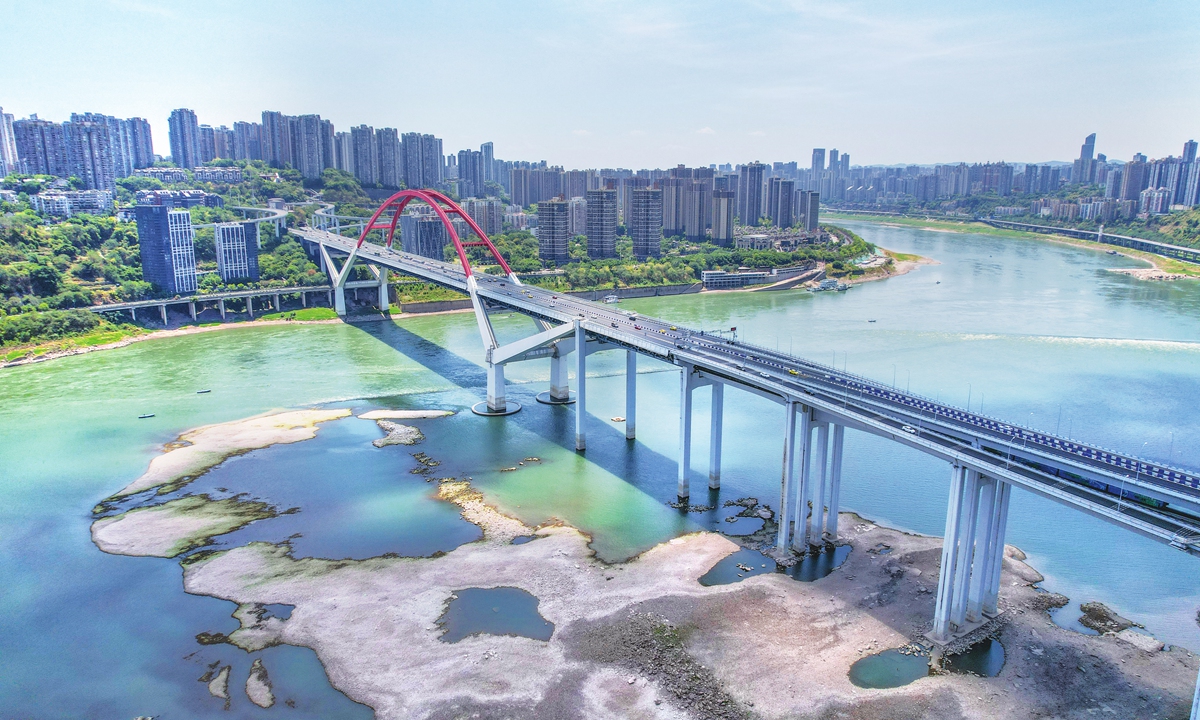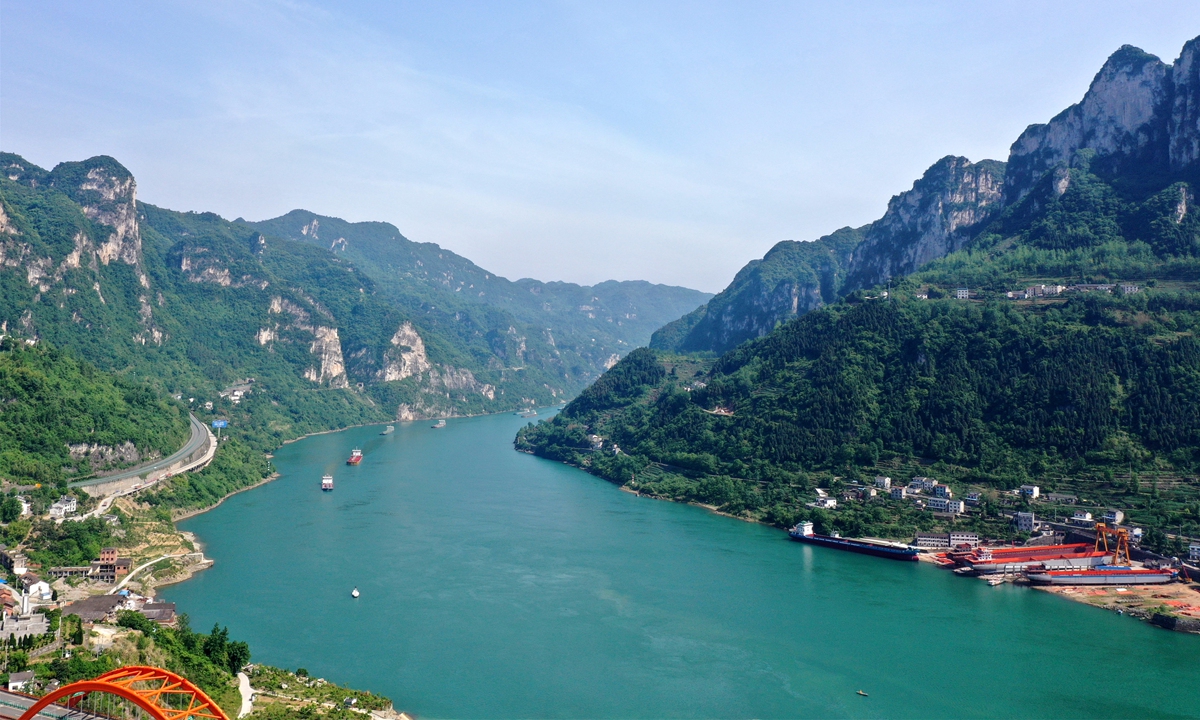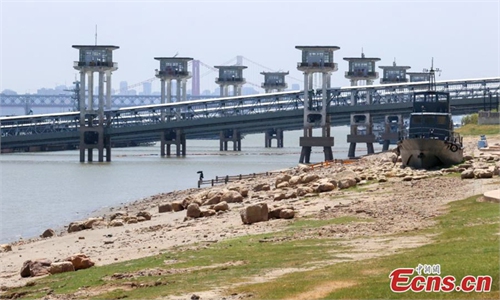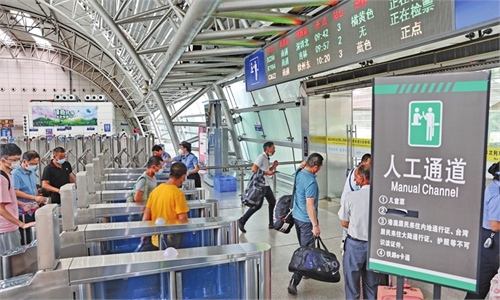Yangtze River basin faces severe drought after experiencing lowest rainfall for six decades

Water levels in the Yangtze River that flows through Southwest China's Chongqing Municipality have declined due to a prolonged drought, revealing parts of the river bed, on August 17, 2022. Photo: VCG

A view of Yangtze River. Photo: IC
Chinese President Xi Jinping on Tuesday ordered local authorities in Northeast China's Liaoning Province to ensure the safety of people's lives in flood control, the Xinhua News Agency reported on Wednesday. During his inspection of comprehensive environmental improvement work along two rivers in Liaoning's Jinzhou city, Xi, also general secretary of the Communist Party of China Central Committee, was briefed about the province's flood control and relief efforts.He asked Party committees and governments at all levels to take solid flood control and relief measures, make appropriate arrangements for those affected by floods and ensure their safety.
Ever since the summer rainy season started in early June, Liaoning has weathered 13 severe rainstorms, which caused the biggest flooding in Panjin in Liaoning since hydrological records began, according to media reports.
Aside from floods in northern China, southern China has been in the grip of an extended heat wave and drought. By Wednesday, the National Meteorological Center (NMC) had issued alerts for heat waves for 28 consecutive days.
As the Yangtze River basin is in the grip of a severe drought with sizzling temperatures for more than two months and the lowest rainfall in six decades, many parts of the region, especially Southwest China's Sichuan Province, are reaching their limit of electricity. Observers said conditions will ease by the end of August as North China consumes less, and power companies allocate electricity from the nationwide grid to help regions in need.
Many of China's most important grain-producing regions are suffering from drought, heat waves, or have been battered by floods, particularly in Northeast China, which is usually dryer.
With the autumn harvest only about 50 days away, agricultural specialists are confident that the extreme weather will not adversely affect food production, as short-term weather impacts on corps will be limited, and water conservancy projects could guarantee irrigation for crops.
Drought conditions have persisted across much of southwestern China for more than two months. An official from the Ministry of Water Resources (MWR) said at a Wednesday conference that the Yangtze River basin has had the lowest summer rainfall since 1961.
In Southwest China's Chongqing, 51 rivers have dried up after baking under temperatures of over 40 C for eight consecutive days, and 24 reservoirs have dried up.
This year's heat wave is the strongest since China started meteorological observations in 1961, and the longest, Sun Shao, a senior research fellow from the Chinese Academy of Meteorological Sciences, told the Global Times on Wednesday, noting that along with the unusually low levels of precipitation in the Yangtze River basin, it has caused a severe drought crisis.
The drought in most areas of the Yangtze River basin is expected to worsen for at least the next 14 days due to continuous high temperatures and lack of rainfall, Sun said.
Later, the drought in the upper reaches of the Yangtze River will be eased as precipitation will improve but the precipitation in the middle and lower reaches of the river will still be low, making meteorological drought in those areas continue to develop, Sun noted.
The Changjiang Water Resources Commission which manages water resources of the Yangtze River basin, released 5.3 billion cubic meters of water from large-scale reservoirs, including 1.09 billion cubic meters from the Three Gorges Reservoir, to alleviate the drought conditions in the middle and lower reaches of the Yangtze River region from August 1 to 15 (Monday). This has helped to some extent, a staffer from the commission who asked for anonymity told the Global Times on Wednesday.

Aerial view of Shanghai Photo: VCG
Temporary shortageThe rare drought has pushed electricity usage of some places, especially Sichuan Province where 80 percent of its electricity comes from hydropower, to the limit.
The Sichuan branch of China's State Grid Corporation said that the province's capacity to produce hydroelectricity has been halved due to the extreme weather.
Sichuan notified a large number of industrial enterprises in the province to suspend production for six days to guarantee people's livelihood, as the high temperatures were straining the capacity of the power grid, media reported on Monday.
Dazhou, a city in Sichuan, notified its residents that the time of rolling blackouts will be extended from 2.5 hours on Tuesday to three hours on Wednesday, The Paper reported on Wednesday. The media also reported that some office buildings in provincial capital Chengdu had turned off the air conditioner to save power.
A total of 3,300 companies in Ningbo, East China's Zhejiang Province have agreed to avoid using electricity in peak time, and they are to be subsidized by the government for doing so, media reported.
The electricity shortage will exert pressure on production in relevant areas, but the influence is limited, as China currently relies mainly on power plants, and it is already mid-August. Since temperatures north of the Yangtze River are dropping, electricity use will drop in a week or so, so the power shortage problem will be greatly relieved by the end of August, Cao Heping, an economist at Peking University, told the Global Times on Wednesday.
Experts said that places that rely heavily on hydroelectricity will bear the brunt of the power shortages, and the central government can allocate national resources to assuage their current pain.
The State Grid Corporation said on Wednesday that it is urgently allocating electricity from outside Sichuan to assist the province, and it will use maximum efforts to support Sichuan and adjacent Chongqing, which is also facing a severe power shortage.
Lin Boqiang, director of the China Center for Energy Economics Research at Xiamen University, said the power shortage that challenges Sichuan and other places serves as a reminder for companies to diversify their energy choices and embrace new energy, such as nuclear, and make pre-arranged plans for climate disasters. "Since heat waves and droughts will return again and often, enterprises need to mitigate for these weather-related events," Lin said.
Food, water guaranteed
Food and household water consumption are also concerns triggered by the extreme weather as many of China's big crop producers including Hunan, Hubei and Henan provinces in Central China are wilting under the extreme heat and drought, and Northeast China's grain belt has suffered the opposite problem of floods.
According to statistics from the MWR, as of Tuesday, a total of 830,000 people in six provincial-level regions, including Sichuan, Chongqing, Hubei and Hunan, are impacted by drought, with 9.67 million mu (644,666 hectares) of crops affected.
The ministry said that some parts of the Yangtze River basin have not seen rainfall for more than 20 days.
China's Ministry of Agriculture and Rural Affairs has dispatched working groups to the worst-hit areas to guarantee the autumn harvests, Xinhua reported on Sunday.
The autumn harvest accounts for 75 percent of China's total grain output, and it is only about 50 days away.
Li Guoxiang, a research fellow at the Rural Development Institute under the Chinese Academy of Social Sciences, told the Global Times that although there should be alarm over the drought, the Yangtze River basin has well-functioning water conservancy projects, which would guarantee irrigation even under severe drought conditions.
If the drought continues, places that are hit hard can use groundwater for irrigation, or start planting drought-resisting crops, such as maize, Li said.
Except for food, many local governments in the grip of drought are striving to guarantee residents' drinking water. Eight cities in Hubei dispatched 21,226 people to send emergency drinking water, weighing 1,530 tons, to all the villages in the province.
Recently, an online rumor claimed Chongqing's Chengkou county only has enough water to support the city's population for 10 days. Hu Honghao, an official from Chongqing's water resource bureau, told the Global Times on Wednesday that the county has around 2 million cubic meters of water reserve, which is enough for the county's 198,000 residents for three months.






